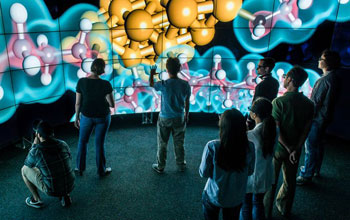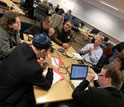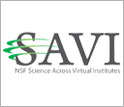News Release 13-031
International Team Targets Innovations in STEM Learning
U.S-Finnish collaboration through Science Across Virtual Institutes (SAVI) brings the strengths of each country to bear on improving science, technology, engineering and mathematics education in K-16 classrooms

SAVI is a mechanism to foster interaction among scientists, engineers and educators around the globe
February 25, 2013
This material is available primarily for archival purposes. Telephone numbers or other contact information may be out of date; please see current contact information at media contacts.
Students in Finland have a reputation for doing well on international assessments in science and mathematics, an accomplishment that's long been of interest to educators and policy makers here in the U.S. A new research collaboration between the two countries is aimed at advancing the best ideas from both sides of the ocean, with the goal of bringing new innovations to science, technology, engineering and mathematics (STEM) education in environments from kindergarten through undergraduate education.
Coordinated by Eric Hamilton at Pepperdine University on the U.S. side and Jari Multisilta of Helsinki University on the Finnish side, this collaboration--titled Innovations in Learning and Education--encompasses eight different yet complementary projects, each with U.S. and Finnish team members, with funding from NSF, Tekes--the Finnish Agency for Technology and Innovation--and the Academy of Finland. The projects together represent a combined U.S.-Finnish investment of about $4 million in grant awards under the Science Across Virtual Institutes (SAVI) effort. "Each team has different research objectives and goals, but all of the teams share a vision to foster deep and immersive engagement in learners and learner communities," said Hamilton.
"We consider it really important to have this international collaboration," added Multisilta. "Finland is such a small country and we want to exchange the research ideas between people in the U.S.--we know that you are very advanced in technology and that's an area we can learn from you."
This is the first SAVI collaboration devoted to STEM education. It provides an opportunity to apply rigorous research methods to evaluate the success of STEM teaching and learning with different approaches and tools. Among the projects is one centered on a massive open online course (MOOC) on calculus that is currently offered at the University of Helsinki and reaches students at 15 institutions in 11 countries. With U.S. collaborators from George Mason University (GMU), Florida State University, Texas A&M and Northwestern, the project calls for analyzing calculus learning by undergraduates and high-school students using extensive log data available on student behaviors and assessments.
"MOOCs are an emerging phenomenon in online education with major projects at Stanford, Harvard and other universities," said GMU Professor Eamonn Kelly. "This project will examine a MOOC in existence for almost a decade based at Florida State University and the University of Helsinki. A range of experts in learning, mathematics education, and data analysis are providing analytic perspectives on existing data, and models for new data-collection functionality, moving forward. SAVI funding makes international collaboration on this global initiative possible."
Video studies factor into a project aimed at expanding STEM learning and teaching using mobile video. Designed for middle-school and high-school students, the project--led by Stanford and the University of Helsinki and also involving Pepperdine University and the University of Lapland--provides for a novel approach to student modeling of science by using digital video cameras in the natural world, giving students and teachers the means to capture, scrutinize and make sense of STEM-rich phenomena through video.
The use of "empathic" and life-like avatars as cognitive tutors developed in the U.S. is central to a project that uses an online game developed in Finland to help elementary and middle-school students with fluent reading and deep comprehension of science texts. Both collaborators have documented important success in advancing student science literacy. The collaboration creates a breakthrough for each side, enabling a successful game to give students an online tutor who can engage in dialogue with them, customize their learning experience, and help them understand and use key concepts before moving on to other lessons. For the researchers, from Boulder Learning Technologies, Southern Methodist University, the University of Jyvaskyla, and Pepperdine University, this project links related but heretofore independent lines of research on reading, literacy and reading comprehension in STEM.
Each of these three examples brings researchers together to capitalize on important work by the other side of each bilateral team. Not only do members meet important needs and furnish tools to one another within their respective teams, the teams all contribute to the SAVI's broader quest to advance its vision for high engagement as a routine experience for all learners. "The individual teams are already relying on other teams in the SAVI for new methods, measurements and ways to understand their own work," Hamilton noted.
The project website provides details on each of the eight bilateral projects and research teams and serves as a portal for collaboration. It also provides information on a series of one-hour webinars aimed at educators, researchers and policy makers. The webinars, to be offered monthly starting in April 2013, will offer updates on the cross-cutting theme of learner engagement and notable advances by the SAVI team members; an in-depth treatment of the innovation, research and development in each individual project; and a webinar discussion.
"For the Academy of Finland, this SAVI on innovations in learning and education is associated with the four-year multidisciplinary research program, 'Future of Learning and Knowledge'," said Risto Vilkko, Program Manager at the Academy of Finland. "The Academy strongly supports international collaboration and mobility of researchers and research results in all of its funding opportunities."
"For Tekes, the cooperation projects are part of the Learning Solutions program that combines business solutions, learning in schools and educational institutions, and research aiming at creating new competencies," said Eero Silvennoinen, director of software and telecommunications technologies at the Finnish funding agency. "Cooperation with U.S. researches opens important new opportunities in subjects such as learning through games, multicultural challenges and making use of information technology and social media."
Support for these projects on the U.S. side reflects a collaboration among several disciplines. Funding is provided by NSF's directorates for Education and Human Resources; Engineering; Computer and Information Science and Engineering; Social, Behavioral and Economic Sciences; and the Office of International and Integrative Activities.
"The Engineering Directorate is particularly interested in engaging students from diverse backgrounds into the discipline, so international partnerships provide a natural opportunity to study and adapt various learning environments and cultures," said Theresa Maldonado, division director for Engineering Education and Centers. "Also, this inaugural set of research projects will generate tremendous amounts of data that, when mined and analyzed, can inform us of important research directions to explore in the future for greater impact."
"This SAVI project allows U.S. and international partners to support some important research focused on the engagement of learners in innovative settings," said Joan Ferrini-Mundy, NSF's assistant director in the Education and Human Resources directorate. "We know how to get students excited about science in specific settings--we want to understand what it takes to engage them deeply in sustained ways."
Information about the eight projects follows:
Advancing an Online Project in the Assessment and Effective Teaching of Calculus
George Mason University, University of Helsinki, Florida State University, Texas A&M University, University of Helsinki
Researchers from the U.S. and Finland are conducting ground-breaking analyses on a massive open online course (MOOC) on calculus that is based at the University of Helsinki: the World Education Portals (WEPS). MOOCs represent a potentially revolutionary development in the design of teaching and learning environments. This project involves several universities in the US and Finland; it is convening a variety of experts on learning, assessment, cognitive diagnostic modeling, and research methodology to: (1) advance the learning of calculus, and (2) recommend best practices on the design, deployment and analysis of this, and other, MOOCs.
Dynamic Digital Text: An Innovation in STEM Education
Auburn University, University of Wisconsin-Madison, Virginia Tech, University of Tampere, VATT, Aalto University, University of Turku
This SAVI effort carries out research on knowledge representation techniques for visualizing and presenting STEM content digitally in order to engage students and engender deep learning. The principal investigators are integrating the results of their research (in an iterative fashion) toward the development of new representation, interaction, and navigation techniques for digital STEM content, Content along with new navigation and automated assessment techniques are being developed and then classroom tested for college-level Computer Science and middle school-level Physics and Biology. Collaboration with researchers in Finland is a key component of this work, as the team is testing its theoretical framework for dynamic digital texts with content in science and computing, for middle school and college, in both Finnish and U.S. educational settings.
Engagement in STEM Learning and Teaching with Mobile Video Inquiries and Communities
University of Helsinki, Michigan State University
Researchers from the U.S. and Finland are collaborating in this SAVI project to investigate how teachers use information about student engagement obtained through smart phone technology to make formative decisions regarding classroom instruction. Recognizing the importance of engagement for student achievement in science, these researchers are testing models to enhance engagement and its connection to teacher practices. This project will contribute to our knowledge base for measuring engagement and its implications for teachers' work in their classrooms.
Expanding STEM Learning and Teaching with Mobile Video Inquiries and Communities
University of Helsinki, University of Lapland, Stanford University, Pepperdine University
The immense quantity of video resulting from digital videocameras everywhere is making video a potentially significant scientific medium for STEM educational purposes. Learning "how to see" scientific and mathematical aspects of real world phenomena and how to raise real questions that foster engagement in inquiries is a key education problem for the STEM disciplines. This SAVI project carries out design-based research to establish a broadly scaleable approach for K-12 learners and teachers to capture mobile video recordings of events and phenomena that spark questions for learners and teachers that can serve as seeds for inquiries and collaborative learning in the STEM disciplines. This collaboration blends distinct but complementary approaches to video-oriented learning science research at the four participating institutions, and seeks to stimulate re-thinking what it means for learners to observe, clarify, expand and represent STEM concepts. It calls for tapping into the 'funds of knowledge' and interests that diverse learners and teachers have from their cultural and community experiences. The four sites will each carry out school-based design experimentation offering the team and the broader SAVI group insights into how this approach to learner-generated video, to 'deepen looking' for 'deeper learning', might be adapted into formal and informal educational settings.
FUN: A Finland-U.S. Network for Engagement and STEM Learning in Games
University of Tampare, Aalto University and University of Jyvaskyla; TERC, Northern Illinois University, WGBH
The Finnish-US Network (FUN) is blending methods and testbeds from both countries to get a broader picture of how engagement and learning are entwined in the growing field of game-based learning. As part of a SAVI, teams from the Educational Gaming Environments group (EdGE) at TERC, WGBH and Northern Illinois University are partering with Finnish researchers from University of Tampere and University of Aalto. Together these groups have an extensive set of research-grounded games in Science, Technology, Engineering, and Mathematics for pre-K, elementary, middle and high school--as well as university-- learners. Each team is this consortium is examining engagement in game-based learning in a different yet complementary way. Methods within the FUN research team include a variety of surveys, video analysis techniques, experience sampling methods, and educational data mining. The FUN researchers are conducting cross-team studies to look for similarities and differences arising in difference cultures and different gaming environments. This research begins this spring with a large national survey of youth 14-18 in both countries to examine the relationships among game experience, gamer identity, science identity, and understanding of the nature of science.
Global Cyber Tools for Improving Young Learners' Reading Comprehension, Scientific Discourse and STEM Learning
Boulder Learning Technologies, Southern Methodist University, University of Jyvaskyla, Pepperdine University
This collaboration takes advantage of a striking complementarity between the successfully piloted My Science Tutor (MyST) Project carried out by Boulder Language Technologies (BLT) and the successful and more widely-used Graphogame (GG) project based in Finland under Dr. Lyytinen's direction at University of Jyvaskyla. The project takes the Graphogame pedagogy for learning foundational word reading skills, and embeds these skills in learning experiences that lead to fluent reading of science texts with deep comprehension using MyST technology. The collaboration will develop and explore English and Spanish versions of Graphogame. Also, it will develop BLT's MindStars Science Books, featuring an empathic and lifelike avatar, adapting Graphogame features to facilitate vocabulary acquisition, oral reading fluency and comprehension strategies that can lead to deep understanding of science by all students, including English learners and struggling readers. The two research groups share a series of research questions that focus on specific questions of literacy and language development, along with broader questions about sustaining the engagement of young learners who use the MyST, Graphogame, and MindStars technologies.
Studying and Supporting Productive Disciplinary Engagement in Demanding STEM Learning
University of Washington, Oregon State University, University of Turku
This early-concept project seeks to build a partnership between two U.S. universities that are currently creating learning environments to support engaged learning in STEM disciplines. This award will allow researchers from these institutions to develop a collaboration with Finnish researchers at Turku University. All three groups have developed innovative learning systems where students take the role of practicing professionals (e.g., as an environmental scientist or a semiconductor process engineer) where they are encouraged to use the "language" and "practices" of the discipline to "get somewhere" (develop a product, improve a process, gain a better understanding of a phenomenon) over time. The collaborative partnership will allow the research team to better understand the nature of engagement in such complex STEM learning environments and to use the understanding to develop methods for creating more effective authentic learning systems that function across many settings and contexts. The contexts also represent cases where students are at risk and might leave paths into STEM careers. The collaboration will yield important insights into increasing the participation and retention of students in the STEM fields.
UNCODE-Uncovering Hidden Cognitive Demands on Global Learners
Stanford University Aalto University, Finnish Institute of Occupational Health
The collaborative proposal will connect the researchers from Stanford with their colleagues in the Finnish Institute of Occupational Health and Aalto University, Finland, to identify the stresses and cognitive demands that are placed on learners who are participating in multi-cultural and cross-disciplinary collaborations in a rich technology-enabled learning environment. The research will be situated in the Architecture, Engineering, Construction Global Teamwork course in the Problem-based Learning Laboratory at Stanford University that engages students in teamwork with partners worldwide. Multiple sources of data will be collected that examine a number of dimensions of student learning experiences including the number of disciplines embodied by the team structure, the number of cultures that influence the communication within the teams, the impact of space and time interactions and the multiple channels by which communication takes place among team members. Physiological data will be collected to identify indicators of stress, and ways that learners and instructions can monitor and self-regulate their well-being and engagement will be identified.
-NSF-
-
International partners meet at an opening meeting at Stanford University in January, 2013.
Credit and Larger Version -
Life-like avatars serve as cognitive tutors in a game to help students comprehend science texts.
Credit and Larger Version -
These projects together represent a combined U.S.-Finnish investment of about $4 million.
Credit and Larger Version
Media Contacts
Maria C. Zacharias, NSF, (703) 292-8454, email: mzachari@nsf.gov
Principal Investigators
Eric Hamilton, Pepperdine University, 310-568-2323, email: Eric.Hamilton@pepperdine.edu
Related Websites
Press release issued by TEKES: http://go.usa.gov/23dW
Press release from Academy of Finland: http://go.usa.gov/23dR
Learning Solutions 2011-2015 Partnership Programme: http://go.usa.gov/23pz
TEKES Learning Solutions: www.tekes.fi/en/document/56406/tekes_learning_solutions_pdf
The U.S. National Science Foundation propels the nation forward by advancing fundamental research in all fields of science and engineering. NSF supports research and people by providing facilities, instruments and funding to support their ingenuity and sustain the U.S. as a global leader in research and innovation. With a fiscal year 2023 budget of $9.5 billion, NSF funds reach all 50 states through grants to nearly 2,000 colleges, universities and institutions. Each year, NSF receives more than 40,000 competitive proposals and makes about 11,000 new awards. Those awards include support for cooperative research with industry, Arctic and Antarctic research and operations, and U.S. participation in international scientific efforts.
Connect with us online
NSF website: nsf.gov
NSF News: nsf.gov/news
For News Media: nsf.gov/news/newsroom
Statistics: nsf.gov/statistics/
Awards database: nsf.gov/awardsearch/
Follow us on social
Twitter: twitter.com/NSF
Facebook: facebook.com/US.NSF
Instagram: instagram.com/nsfgov



